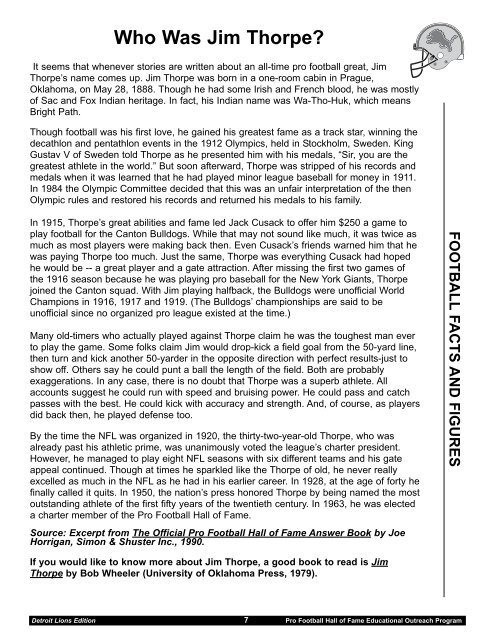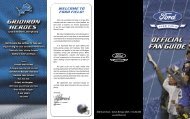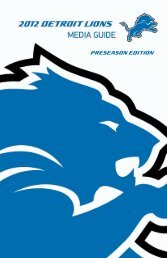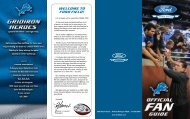Detroit Lions Activity Book.qxp - Detroit Lions - NFL.com
Detroit Lions Activity Book.qxp - Detroit Lions - NFL.com
Detroit Lions Activity Book.qxp - Detroit Lions - NFL.com
- No tags were found...
Create successful ePaper yourself
Turn your PDF publications into a flip-book with our unique Google optimized e-Paper software.
Who Was Jim Thorpe?It seems that whenever stories are written about an all-time pro football great, JimThorpe’s name <strong>com</strong>es up. Jim Thorpe was born in a one-room cabin in Prague,Oklahoma, on May 28, 1888. Though he had some Irish and French blood, he was mostlyof Sac and Fox Indian heritage. In fact, his Indian name was Wa-Tho-Huk, which meansBright Path.Though football was his first love, he gained his greatest fame as a track star, winning thedecathlon and pentathlon events in the 1912 Olympics, held in Stockholm, Sweden. KingGustav V of Sweden told Thorpe as he presented him with his medals, “Sir, you are thegreatest athlete in the world.” But soon afterward, Thorpe was stripped of his records andmedals when it was learned that he had played minor league baseball for money in 1911.In 1984 the Olympic Committee decided that this was an unfair interpretation of the thenOlympic rules and restored his records and returned his medals to his family.In 1915, Thorpe’s great abilities and fame led Jack Cusack to offer him $250 a game toplay football for the Canton Bulldogs. While that may not sound like much, it was twice asmuch as most players were making back then. Even Cusack’s friends warned him that hewas paying Thorpe too much. Just the same, Thorpe was everything Cusack had hopedhe would be -- a great player and a gate attraction. After missing the first two games ofthe 1916 season because he was playing pro baseball for the New York Giants, Thorpejoined the Canton squad. With Jim playing halfback, the Bulldogs were unofficial WorldChampions in 1916, 1917 and 1919. (The Bulldogs’ championships are said to beunofficial since no organized pro league existed at the time.)Many old-timers who actually played against Thorpe claim he was the toughest man everto play the game. Some folks claim Jim would drop-kick a field goal from the 50-yard line,then turn and kick another 50-yarder in the opposite direction with perfect results-just toshow off. Others say he could punt a ball the length of the field. Both are probablyexaggerations. In any case, there is no doubt that Thorpe was a superb athlete. Allaccounts suggest he could run with speed and bruising power. He could pass and catchpasses with the best. He could kick with accuracy and strength. And, of course, as playersdid back then, he played defense too.By the time the <strong>NFL</strong> was organized in 1920, the thirty-two-year-old Thorpe, who wasalready past his athletic prime, was unanimously voted the league’s charter president.However, he managed to play eight <strong>NFL</strong> seasons with six different teams and his gateappeal continued. Though at times he sparkled like the Thorpe of old, he never reallyexcelled as much in the <strong>NFL</strong> as he had in his earlier career. In 1928, at the age of forty hefinally called it quits. In 1950, the nation’s press honored Thorpe by being named the mostoutstanding athlete of the first fifty years of the twentieth century. In 1963, he was electeda charter member of the Pro Football Hall of Fame.Source: Excerpt from The Official Pro Football Hall of Fame Answer <strong>Book</strong> by JoeHorrigan, Simon & Shuster Inc., 1990.FOOTBALL FACTS AND FIGURESIf you would like to know more about Jim Thorpe, a good book to read is JimThorpe by Bob Wheeler (University of Oklahoma Press, 1979).<strong>Detroit</strong> <strong>Lions</strong> Edition 7 Pro Football Hall of Fame Educational Outreach Program









